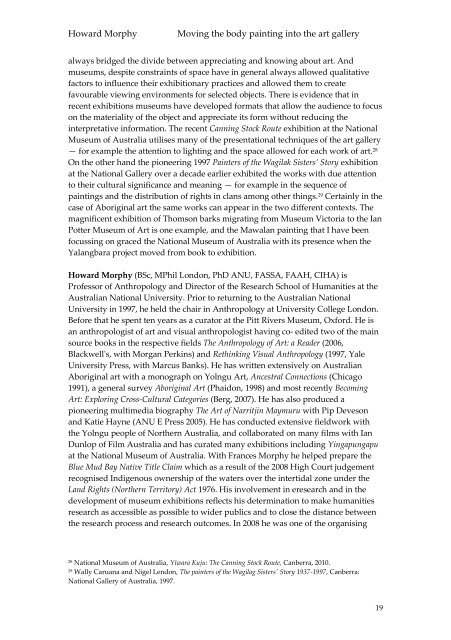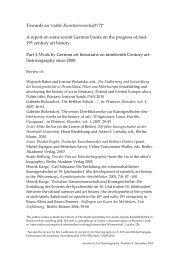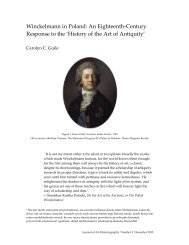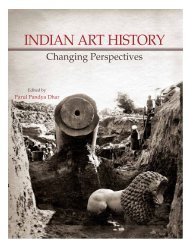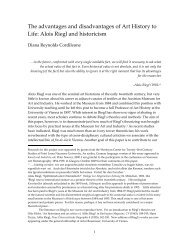Moving the body painting into the art gallery - Journal of Art ...
Moving the body painting into the art gallery - Journal of Art ...
Moving the body painting into the art gallery - Journal of Art ...
You also want an ePaper? Increase the reach of your titles
YUMPU automatically turns print PDFs into web optimized ePapers that Google loves.
Howard Morphy <strong>Moving</strong> <strong>the</strong> <strong>body</strong> <strong>painting</strong> <strong>into</strong> <strong>the</strong> <strong>art</strong> <strong>gallery</strong><br />
always bridged <strong>the</strong> divide between appreciating and knowing about <strong>art</strong>. And<br />
museums, despite constraints <strong>of</strong> space have in general always allowed qualitative<br />
factors to influence <strong>the</strong>ir exhibitionary practices and allowed <strong>the</strong>m to create<br />
favourable viewing environments for selected objects. There is evidence that in<br />
recent exhibitions museums have developed formats that allow <strong>the</strong> audience to focus<br />
on <strong>the</strong> materiality <strong>of</strong> <strong>the</strong> object and appreciate its form without reducing <strong>the</strong><br />
interpretative information. The recent Canning Stock Route exhibition at <strong>the</strong> National<br />
Museum <strong>of</strong> Australia utilises many <strong>of</strong> <strong>the</strong> presentational techniques <strong>of</strong> <strong>the</strong> <strong>art</strong> <strong>gallery</strong><br />
— for example <strong>the</strong> attention to lighting and <strong>the</strong> space allowed for each work <strong>of</strong> <strong>art</strong>. 28<br />
On <strong>the</strong> o<strong>the</strong>r hand <strong>the</strong> pioneering 1997 Painters <strong>of</strong> <strong>the</strong> Wagilak Sisters’ Story exhibition<br />
at <strong>the</strong> National Gallery over a decade earlier exhibited <strong>the</strong> works with due attention<br />
to <strong>the</strong>ir cultural significance and meaning — for example in <strong>the</strong> sequence <strong>of</strong><br />
<strong>painting</strong>s and <strong>the</strong> distribution <strong>of</strong> rights in clans among o<strong>the</strong>r things. 29 Certainly in <strong>the</strong><br />
case <strong>of</strong> Aboriginal <strong>art</strong> <strong>the</strong> same works can appear in <strong>the</strong> two different contexts. The<br />
magnificent exhibition <strong>of</strong> Thomson barks migrating from Museum Victoria to <strong>the</strong> Ian<br />
Potter Museum <strong>of</strong> <strong>Art</strong> is one example, and <strong>the</strong> Mawalan <strong>painting</strong> that I have been<br />
focussing on graced <strong>the</strong> National Museum <strong>of</strong> Australia with its presence when <strong>the</strong><br />
Yalangbara project moved from book to exhibition.<br />
Howard Morphy (BSc, MPhil London, PhD ANU, FASSA, FAAH, CIHA) is<br />
Pr<strong>of</strong>essor <strong>of</strong> Anthropology and Director <strong>of</strong> <strong>the</strong> Research School <strong>of</strong> Humanities at <strong>the</strong><br />
Australian National University. Prior to returning to <strong>the</strong> Australian National<br />
University in 1997, he held <strong>the</strong> chair in Anthropology at University College London.<br />
Before that he spent ten years as a curator at <strong>the</strong> Pitt Rivers Museum, Oxford. He is<br />
an anthropologist <strong>of</strong> <strong>art</strong> and visual anthropologist having co- edited two <strong>of</strong> <strong>the</strong> main<br />
source books in <strong>the</strong> respective fields The Anthropology <strong>of</strong> <strong>Art</strong>: a Reader (2006,<br />
Blackwell's, with Morgan Perkins) and Rethinking Visual Anthropology (1997, Yale<br />
University Press, with Marcus Banks). He has written extensively on Australian<br />
Aboriginal <strong>art</strong> with a monograph on Yolngu <strong>Art</strong>, Ancestral Connections (Chicago<br />
1991), a general survey Aboriginal <strong>Art</strong> (Phaidon, 1998) and most recently Becoming<br />
<strong>Art</strong>: Exploring Cross-Cultural Categories (Berg, 2007). He has also produced a<br />
pioneering multimedia biography The <strong>Art</strong> <strong>of</strong> Narritjin Maymuru with Pip Deveson<br />
and Katie Hayne (ANU E Press 2005). He has conducted extensive fieldwork with<br />
<strong>the</strong> Yolngu people <strong>of</strong> Nor<strong>the</strong>rn Australia, and collaborated on many films with Ian<br />
Dunlop <strong>of</strong> Film Australia and has curated many exhibitions including Yingapungapu<br />
at <strong>the</strong> National Museum <strong>of</strong> Australia. With Frances Morphy he helped prepare <strong>the</strong><br />
Blue Mud Bay Native Title Claim which as a result <strong>of</strong> <strong>the</strong> 2008 High Court judgement<br />
recognised Indigenous ownership <strong>of</strong> <strong>the</strong> waters over <strong>the</strong> intertidal zone under <strong>the</strong><br />
Land Rights (Nor<strong>the</strong>rn Territory) Act 1976. His involvement in eresearch and in <strong>the</strong><br />
development <strong>of</strong> museum exhibitions reflects his determination to make humanities<br />
research as accessible as possible to wider publics and to close <strong>the</strong> distance between<br />
<strong>the</strong> research process and research outcomes. In 2008 he was one <strong>of</strong> <strong>the</strong> organising<br />
28 National Museum <strong>of</strong> Australia, Yiwara Kuju: The Canning Stock Route, Canberra, 2010.<br />
29 Wally Caruana and Nigel Lendon, The painters <strong>of</strong> <strong>the</strong> Wagilag Sisters' Story 1937-1997, Canberra:<br />
National Gallery <strong>of</strong> Australia, 1997.<br />
19


